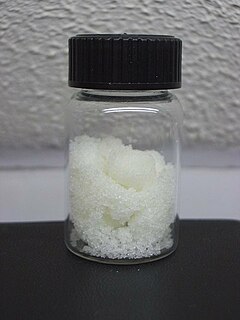
Sodium nitrite is an inorganic compound with the chemical formula NaNO2. It is a white to slightly yellowish crystalline powder that is very soluble in water and is hygroscopic. From an industrial perspective, it is the most important nitrite salt. It is a precursor to a variety of organic compounds, such as pharmaceuticals, dyes, and pesticides, but it is probably best known as a food additive used in processed meats and (in some countries) in fish products.

Cheez Whiz is a brand of processed cheese sauce or spread produced by Kraft Foods. It was developed by a team led by food scientist Edwin Traisman (1915–2007). While many sources give its national debut as 1953, it was advertised by Kraft and retailers in several states in late 1952.

Sodium benzoate is the sodium salt of benzoic acid, widely used as a food preservative (with an E number of E211) and a pickling agent. It appears as a white crystalline chemical with the formula C6H5COONa.
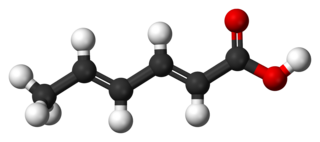
Sorbic acid, or 2,4-hexadienoic acid, is a natural organic compound used as a food preservative. It has the chemical formula CH3(CH)4CO2H. It is a colourless solid that is slightly soluble in water and sublimes readily. It was first isolated from the unripe berries of the Sorbus aucuparia (rowan tree), hence its name..

Velveeta is a brand name for a processed cheese product similar to American cheese. It was invented in 1918 by Emil Frey of the "Monroe Cheese Company" in Monroe, New York. In 1923, "The Velveeta Cheese Company" was incorporated as a separate company. In 1925, it advertised two varieties, Swiss and American. The firm was purchased by Kraft Foods Inc. in 1927.
Pepsi Wild Cherry is a cherry-flavored cola first introduced in 1988 by PepsiCo as a replacement for Cherry Cola Slice, introduced as part of the line in 1986. Two sugar-free versions are also available, with zero calories, named Diet Pepsi Wild Cherry and Pepsi Zero Sugar Wild Cherry, and a vanilla-flavored version Pepsi Cherry Vanilla is also available. Alongside the beverages, a Lip Balm version is also available. Pepsi Wild Cherry is currently sold in the United States and Canada as a regular, permanent product.

Sodium acetate, NaCH3COO, also abbreviated NaOAc, is the sodium salt of acetic acid. This colorless deliquescent salt has a wide range of uses.
Nutrinova is a global manufacturer of food constituents. It was formerly a division of Hoechst until 1997 when it was taken over by Celanese and adopted its current name.

Potassium sorbate is the potassium salt of sorbic acid, chemical formula CH3CH=CH−CH=CH−CO2K. It is a white salt that is very soluble in water (58.2% at 20 °C). It is primarily used as a food preservative (E number 202). Potassium sorbate is effective in a variety of applications including food, wine, and personal-care products. While sorbic acid occurs naturally in some berries, virtually all of the world's supply of sorbic acid, from which potassium sorbate is derived, is manufactured synthetically.

Acidity regulators, or pH control agents, are food additives used to change or maintain pH. They can be organic or mineral acids, bases, neutralizing agents, or buffering agents. Typical agents include the following acids and their sodium salts: sorbic acid, acetic acid, benzoic acid, and propionic acid. Acidity regulators are indicated by their E number, such as E260, or simply listed as "food acid".

Calcium sorbate is the calcium salt of sorbic acid. Calcium sorbate is a polyunsaturated fatty acid salt.

Propel Water is an American brand of flavored bottled water that is advertised for having antioxidants and vitamins. It is a beverage product of Gatorade and is marketed by PepsiCo.

Zygosaccharomyces bailii is a species in the genus Zygosaccharomyces. It was initially described as Saccharomyces bailii by Lindner in 1895, but in 1983 it was reclassified as Zygosaccharomyces bailii in the work by Barnett et al.
Fruit2O, formerly manufactured by Kraft, is a lightly flavored, non-carbonated water beverage introduced in 1999. Fruit2o was introduced to compete not only with the bottled water market but also with the soft drink market. Sunny Delight Beverages purchased the Veryfine Products line from Kraft in 2007.
Acid–base extraction is a procedure using sequential liquid–liquid extractions to purify acids and bases from mixtures based on their chemical properties.
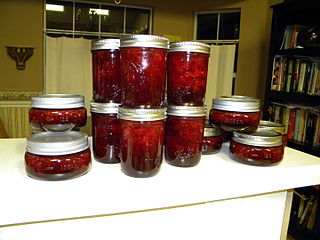
Gelling sugar or (British) Jam sugar or (US) Jelly sugar or sugar with pectin is a kind of sugar that is used to produce preserves, and which contains pectin as a gelling agent. It also usually contains citric acid as a preservative, sometimes along with other substances, such as sorbic acid or sodium benzoate
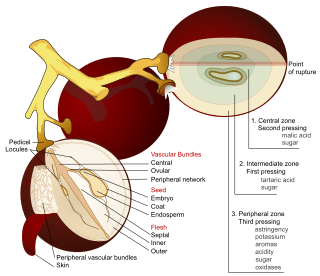
The acids in wine are an important component in both winemaking and the finished product of wine. They are present in both grapes and wine, having direct influences on the color, balance and taste of the wine as well as the growth and vitality of yeast during fermentation and protecting the wine from bacteria. The measure of the amount of acidity in wine is known as the “titratable acidity” or “total acidity”, which refers to the test that yields the total of all acids present, while strength of acidity is measured according to pH, with most wines having a pH between 2.9 and 3.9. Generally, the lower the pH, the higher the acidity in the wine. There is no direct connection between total acidity and pH. In wine tasting, the term “acidity” refers to the fresh, tart and sour attributes of the wine which are evaluated in relation to how well the acidity balances out the sweetness and bitter components of the wine such as tannins. Three primary acids are found in wine grapes: tartaric, malic, and citric acids. During the course of winemaking and in the finished wines, acetic, butyric, lactic, and succinic acids can play significant roles. Most of the acids involved with wine are fixed acids with the notable exception of acetic acid, mostly found in vinegar, which is volatile and can contribute to the wine fault known as volatile acidity. Sometimes, additional acids, such as ascorbic, sorbic and sulfurous acids, are used in winemaking.
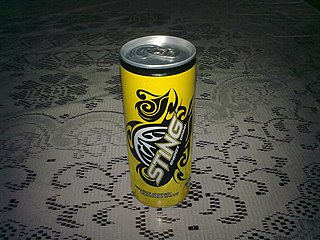
Sting Energy is a carbonated energy drink from PepsiCo International and produced by Rockstar Inc. Sting is available in flavours such as original Gold Rush, Gold, Power Pacq, Power Lime (Kiwifruit/Lime) and Berry Blast (Strawberry).
Citrus Blast is a caffeine-free, grapefruit-citrus flavored soft drink produced by PepsiCo.
















